Evaluating the Incorporation of Ecological Conscious Building Design Methods in Architectural Education
Abstract
1. Introduction
- How do architecture students and expert lecturers differently prioritize LEED criteria within ecological conscious building design (ECBD) education?
- What gaps exist between the intended pedagogical goals of ECBD courses and the practical outcomes, perceived by students and experts?
2. Theoretical and Background of the Study
3. Materials and Methods
3.1. Case Study
3.2. Criteria Development Based on LEED
3.3. Data Collection and Analysis
4. Analysis
4.1. Location and Transportation
4.2. Sustainable Sites
4.3. Water Efficiency
4.4. Energy and Atmosphere
4.5. Materials and Resources
4.6. Indoor Environmental Quality
4.7. Innovation
4.8. Regional Priority
5. Discussion
Practical Implications for Academia and Industry
6. Conclusions
Limitation and Future Studies
Supplementary Materials
Author Contributions
Funding
Data Availability Statement
Conflicts of Interest
Abbreviations
| ECBD | Ecological Conscious Building Design |
| LEED | Leadership in Energy and Environmental Design |
| AHP | Analytic Hierarchy Process |
| VOC | Volatile Organic Compounds |
| UN | United Nations |
| UNESCO | The United Nations Educational, Scientific and Cultural Organization |
References
- Altomonte, S.; Yannas, S.; Herde, A.D.; Riemer, A.; Cangelli, E.; Horvath, S.; LopezDeAsiain, M. Education for Sustainable Environmental Design—The EDUCATE Project; Educate Press University: Notthingham, UK, 2012. [Google Scholar]
- Grant, E.J. Mainstreaming environmental education for architects: The need for basic literacies. Build. Cities 2020, 1, 538–549. [Google Scholar] [CrossRef]
- Lotfabadi, P.; Hançer, P. Optimization of visual comfort: Building openings. J. Build. Eng. 2023, 72, 106598. [Google Scholar] [CrossRef]
- Domenica Iulo, L.; Gorby, C.; Poerschke, U.; Nickolas Kalisperis, L.; Woollen, M. Environmentally conscious design—Educating future architects. Int. J. Sustain. High. Educ. 2013, 14, 434–448. [Google Scholar] [CrossRef]
- US Green Building Council. LEED v4 for Building Design and Construction. Available online: https://www.usgbc.org (accessed on 1 September 2023).
- Bhushan, N.; Rai, K. Strategic Decision-Making. In Strategic Decision Making: Applying the Analytic Hierarchy Process; Bhushan, N., Rai, K., Eds.; Springer: London, UK, 2004; pp. 3–10. [Google Scholar]
- Saaty, T.L. Multicriteria Decision Making: The Analytic Hierarchy Process: Planning, Priority Setting Resource Allocation, 2nd ed.; RWS Publications: Pittsburgh, PA, USA, 1990. [Google Scholar]
- Saaty, T.L. What is the Analytic Hierarchy Process? In Mathematical Models for Decision Support; Springer: Berlin/Heidelberg, Germany, 1988; pp. 109–121. [Google Scholar]
- Boarin, P.; Martinez-Molina, A. Integration of environmental sustainability considerations within architectural programmes in higher education: A review of teaching and implementation approaches. J. Clean. Prod. 2022, 342, 130989. [Google Scholar] [CrossRef]
- Ismail, M.A.; Keumala, N.; Dabdoob, R.M. Review on integrating sustainability knowledge into architectural education: Practice in the UK and the USA. J. Clean. Prod. 2017, 140, 1542–1552. [Google Scholar] [CrossRef]
- Hassanpour, B.; Alpar Atun, R.; Ghaderi, S. From Words to Action: Incorporation of Sustainability in Architectural Education. Sustainability 2017, 9, 1790. [Google Scholar] [CrossRef]
- Rieh, S.-Y.; Lee, B.-Y.; Oh, J.-G.; Schuetze, T.; Porras Álvarez, S.; Lee, K.; Park, J. Integration of Sustainability into Architectural Education at Accredited Korean Universities. Sustainability 2017, 9, 1121. [Google Scholar] [CrossRef]
- Bradecki, T.; Uherek-Bradecka, B.; Tofiluk, A.; Laar, M.; Natanian, J. Towards Sustainable Education by Design: Evaluating Pro-Ecological Architectural Solutions in Centers for Environmental Education. Sustainability 2024, 16, 5053. [Google Scholar] [CrossRef]
- Healey, M.; Jenkins, A. Developing Undergraduate Research and Inquiry. Available online: https://www.advance-he.ac.uk/knowledge-hub/developing-undergraduate-research-and-inquiry (accessed on 28 May 2023).
- Sara, R. Learning from life–Exploring the potential of live projects in higher education. J. Educ. Built Environ. 2011, 6, 8–25. [Google Scholar] [CrossRef]
- Fernandez-Antolin, M.-M.; del Río, J.M.; Gonzalez-Lezcano, R.-A. Building performance simulation tools as part of architectural design: Breaking the gap through software simulation. Int. J. Technol. Des. Educ. 2022, 32, 1227–1245. [Google Scholar] [CrossRef]
- McDiarmid, G.W.; Zhao, Y. Learning for Uncertainty: Teaching Students How to Thrive in a Rapidly Evolving World; Routledge: New York, NY, USA, 2022. [Google Scholar]
- Pigott, J. Less is more: Education for uncertain times. Glob. Soc. Educ. 2022, 20, 251–261. [Google Scholar] [CrossRef]
- Bashabsheh, A.K.; Alzoubi, H.H.; Ali, M.Z. The application of virtual reality technology in architectural pedagogy for building constructions. Alex. Eng. J. 2019, 58, 713–723. [Google Scholar] [CrossRef]
- BCEURU Boyer Commission on Educating Undergraduates in the Research University. Reinventing Undergraduate Education: A blueprint for America’s Research Universities; BCEURU Boyer Commission on Educating Undergraduates in the Research University: Fort Collins, CO, USA, 1988. [Google Scholar]
- Salama, A.M. Learning from the Environment: Evaluation Research and Experience Based Architectural Pedagogy. CEBE Trans. 2006, 3, 64–83. [Google Scholar] [CrossRef]
- Orellana, I.; Fauteux, S. Environmental education: Tracing the high points of its history. In The Future of Environmental Education in a Postmodern World; Yukon College: Whitehorse, YT, Canada, 1998. [Google Scholar]
- Capra, F. The Web of Life: A New Scientific Understanding of Living Systems; Knopf Doubleday Publishing Group: New York, NY, USA, 1996. [Google Scholar]
- Moore, K.; Geboy, L. The question of evidence: Current worldviews in environmental design research and practice. Archit. Res. Q. 2010, 14, 105–114. [Google Scholar] [CrossRef]
- UN General Assembly (United Nations). Human Rights Council—No. 53 (A/66/53); United Nations: New York, NY, USA, 2010; p. 211. [Google Scholar]
- UNESCO. UN Decade of Education for Sustainable Development 2005–2014: The DESD at a Glance; UNESCO: Paris, France, 2005. [Google Scholar]
- Koehn, P.H. Universities and the Sustainable Development Future: Evaluating Higher-Education Contributions to the 2030 Agenda; Uitto, J.I., Ed.; Routledge: London, UK, 2017. [Google Scholar]
- Dawe, H. Education for sustainable development: How can we fit it into the law curriculum? In Proceedings of the Learning in Law Annual Conference, Coventry, UK, 19–28 January 2011. [Google Scholar]
- Alshuwaikhat, H.M.; Abubakar, I. An integrated approach to achieving campus sustainability: Assessment of the current campus environmental management practices. J. Clean. Prod. 2008, 16, 1777–1785. [Google Scholar] [CrossRef]
- Dodd, M.; Harrisson, F.; Charlesworth, E. Live Projects: Designing with People; RMIT Press: Melbourne, VIC, Australia, 2012. [Google Scholar]
- Lotfabadi, P.; Iranmanesh, A. Evaluation of learning methods in architecture design studio via analytic hierarchy process: A case study. Archit. Eng. Des. Manag. 2023, 20, 47–64. [Google Scholar] [CrossRef]
- Lotfabadi, P.; Mousavi, S.A. Adaptation of Architectural Education Pedagogy in Addressing Covid-19 Pandemic. J. Educ. Technol. Online Learn. 2022, 5, 1094–1105. [Google Scholar] [CrossRef]
- Lotfabadi, P.; Mousavi, S.A. The Effect of Covid-19 Pandemic on Architectural Education Pedagogy. In Proceedings of the International Conference on Educational Technology and Online Learning (ICETOL), Ören, Burhaniye, Turkey, 23–26 June 2022. [Google Scholar]
- Schiano-Phan, R.; Gonçalves, J.C.S.; Vallejo, J.A. Pedagogy Pro-Design and Climate Literacy: Teaching Methods and Research Approaches for Sustainable Architecture. Sustainability 2022, 14, 6791. [Google Scholar] [CrossRef]
- Al-Hagla, K.S. The role of the design studio in shaping an architectural education for sustainable development: The case of Beirut Arab University. Int. J. Archit. Res. Archnet-IJAR 2012, 6, 23–41. [Google Scholar]
- Alabaster, T.; Blair, D. Greening the university. In Education for Sustainability; Routledge: Oxfordshire, UK, 1996; pp. 86–104. [Google Scholar]
- Mintz, K.; Tal, T. Sustainability in higher education courses: Multiple learning outcomes. Stud. Educ. Eval. 2014, 41, 113–123. [Google Scholar] [CrossRef]
- Ceulemans, K.; Molderez, I.; Liedekerke, L.V. Sustainability reporting in higher education: A comprehensive review of the recent literature and paths for further research. J. Clean. Prod. 2015, 106, 127–143. [Google Scholar] [CrossRef]
- Guerra, J.B.S.O.d.A.; Garcia, J.; de Andrade Lima, M.; Barbosa, S.B.; Heerdt, M.L.; Berchin, I.I. A proposal of a Balanced Scorecard for an environmental education program at universities. J. Clean. Prod. 2018, 172, 1674–1690. [Google Scholar] [CrossRef]
- Thürer, M.; Tomaˇsevi’c, I.; Stevenson, M.; Qu, T.; Huisingh, D. A systematic review of the literature on integrating sustainability into engineering curricula. J. Clean. Prod. 2017, 181, 608–617. [Google Scholar] [CrossRef]
- Yüksek, I. The Evaluation of Architectural Education in the Scope of Sustainable Architecture. Procedia—Soc. Behav. Sci. 2013, 89, 496–508. [Google Scholar] [CrossRef]
- Salama, A.M. Skill-Based/Knowledge-Based Architectural Pedagogies: Toward an Alternative for Creating Humane Environments. In Proceedings of the 7th International Conference of the International Association for Humane Habitat—IAHH, Mumbai, India, 29–31 January 2005. [Google Scholar]
- Rapoport, A. The Need for What Knowledge. In Proceedings of the 25th Annual International Conference of the Environmental Design Research Association-EDRA, St. Antonio, TX, USA, 16–20 March 1994; pp. 35–39. [Google Scholar]
- Taylor, A. Linking Architecture and Education: Sustainable Design for Learning Environments; UNM Press: Albuquerque, NM, USA, 2009. [Google Scholar]
- Anthony, K. Design Juries on Trial: The Renaissance of the Studio; Van Nostrand Reinhold: New York, NY, USA, 1991. [Google Scholar]
- Cuff, D. Architecture: The Story of Practice; MIT Press: Cambridge, UK, 1991. [Google Scholar]
- Koch, A.; Schwennsen, K.; Dutton, T.; Smith, D. The Redesign of Studio Culture, Studio Culture Task Force; The American Institute of Architecture Students-AIAS: Washington, DC, USA, 2002. [Google Scholar]
- Mazumdar, S. Cultural Values in Architectural Education. J. Archit. Educ. 1993, 46, 230–237. [Google Scholar]
- Nicol, D.; Pilling, S. Changing Architectural Education: Towards a New Professionalism; Spon Press: London, UK, 2000. [Google Scholar]
- Donald, A.S. Learning a Language, Learning to Design; Consortium of East Coast Schools of Architecture: Cambridge, UK, 1981. [Google Scholar]
- Donald, A.S. The Design Studio: An Exploration of Its Tradition and Potentials; RIBA Publications: London, UK, 1985. [Google Scholar]
- Arthur, E.S. Jungian Epistemological Balance: A Framework for Conceptualizing Architectural Education. J. Archit. Educ. 1994, 48, 105–112. [Google Scholar]
- Teymur, N. City as Education: Habitat II Edition; Question Press: London, UK, 1996. [Google Scholar]
- Saaty, T.L.; Vargas, L.G. Decision Making with the Analytic Network Process; Springer: New York, NY, USA, 2006; Volume 282. [Google Scholar]
- Saaty, T.L. How to make a decision: The analytic hierarchy process. Eur. J. Oper. Res. 1990, 48, 9–26. [Google Scholar] [CrossRef]
- Saaty, T.L. A scaling method for priorities in hierarchical structures. J. Math. Psychol. 1977, 15, 234–281. [Google Scholar] [CrossRef]
- Franco, L.A.; Montibeller, G. Problem Structuring for Multicriteria Decision Analysis Interventions. In Wiley Encyclopedia of Operations Research and Management Science; John Wiley & Sons Inc: Hoboken, NJ, USA, 2011. [Google Scholar]
- Bozorg-Haddad, O.; Zolghadr-Asli, B.; Loaiciga, H.A. A Handbook on Multi-Attribute Decision-Making Methods; John Wiley & Sons: Hoboken, NJ, USA, 2021. [Google Scholar]
- Fahim, A.; Tan, Q.; Naz, B.; Ain, Q.u.; Bazai, S.U. Sustainable Higher Education Reform Quality Assessment Using SWOT Analysis with Integration of AHP and Entropy Models: A Case Study of Morocco. Sustainability 2021, 13, 4312. [Google Scholar] [CrossRef]
- Mahmoud, R.M.A.; Youssef, A.M.A. A computational framework for supporting architectural education of spaces’ furnishing design. Int. J. Archit. Comput. 2022, 20, 346–377. [Google Scholar] [CrossRef]
- Aguarón, J.; Escobar, M.T.; Moreno-Jiménez, J.M. Reducing inconsistency measured by the geometric consistency index in the analytic hierarchy process. Eur. J. Oper. Res. 2021, 288, 576–583. [Google Scholar] [CrossRef]
- Vehbi, B.O.; Günçe, K.; Iranmanesh, A. Multi-Criteria Assessment for Defining Compatible New Use: Old Administrative Hospital, Kyrenia, Cyprus. Sustainability 2021, 13, 1922. [Google Scholar] [CrossRef]
- Darko, A.; Chan, A.P.C.; Ameyaw, E.E.; Owusu, E.K.; Pärn, E.; Edwards, D.J. Review of application of analytic hierarchy process (AHP) in construction. Int. J. Constr. Manag. 2019, 19, 436–452. [Google Scholar] [CrossRef]
- Haggag, A.G.; Zaki, S.H.; Selim, A.M. Emergency camps design using analytical hierarchy process to promote the response plan for the natural disasters. Archit. Eng. Des. Manag. 2023, 19, 305–322. [Google Scholar] [CrossRef]
- Abudayyeh, O.; Zidan Saad, J.; Yehia, S.; Randolph, D. Hybrid Prequalification-Based, Innovative Contracting Model Using AHP. J. Manag. Eng. 2007, 23, 88–96. [Google Scholar] [CrossRef]
- Altomonte, S.; Rutherford, P.; Wilson, R. Mapping the Way Forward: Education for Sustainability in Architecture and Urban Design. Corp. Soc. Responsib. Environ. Manag. 2014, 21, 143–154. [Google Scholar] [CrossRef]
- Chen, P.-H.; Nguyen, T.C. Integrating web map service and building information modeling for location and transportation analysis in green building certification process. Autom. Constr. 2017, 77, 52–66. [Google Scholar] [CrossRef]
- Steinemann, A.; Wargocki, P.; Rismanchi, B. Ten questions concerning green buildings and indoor air quality. Build. Environ. 2017, 112, 351–358. [Google Scholar] [CrossRef]
- Cole, R.J. Building environmental assessment methods: Clarifying intentions. Build. Res. Inf. 1999, 27, 230–246. [Google Scholar] [CrossRef]
- Asdrubali, F.; Baldinelli, G.; Bianchi, F.; Sambuco, S. A comparison between environmental sustainability rating systems LEED and ITACA for residential buildings. Build. Environ. 2015, 86, 98–108. [Google Scholar] [CrossRef]
- Rebelatto, B.G.; Salvia, A.L.; Brandli, L.L.; Leal Filho, W. Examining Energy Efficiency Practices in Office Buildings through the Lens of LEED, BREEAM, and DGNB Certifications. Sustainability 2024, 16, 4345. [Google Scholar] [CrossRef]
- Al-Ramahi, A.; Iranmanesh, A.; Denerel, S.B. Well-Being as an Effective Aspect in the Perception of Vital In-between Spaces within Art and Architecture Faculties. Buildings 2023, 13, 1467. [Google Scholar] [CrossRef]
- Allen, J.G.; MacNaughton, P.; Satish, U.; Santanam, S.; Vallarino, J.; Spengler, J.D. Associations of Cognitive Function Scores with Carbon Dioxide, Ventilation, and Volatile Organic Compound Exposures in Office Workers: A Controlled Exposure Study of Green and Conventional Office Environments. Environ. Health Perspect. 2016, 124, 805–812. [Google Scholar] [CrossRef] [PubMed]
- Fisk, W.J. Health and productivity gains from better indoor environments and their relationship with building energy efficiency. Annu. Rev. Environ. Resour. 2000, 25, 537–566. [Google Scholar] [CrossRef]
- Ambrey, C.L.; Daniels, P. Happiness and footprints: Assessing the relationship between individual well-being and carbon footprints. Environ. Dev. Sustain. 2017, 19, 895–920. [Google Scholar] [CrossRef]
- Fanning, A.L.; O’Neill, D.W. The Wellbeing–Consumption paradox: Happiness, health, income, and carbon emissions in growing versus non-growing economies. J. Clean. Prod. 2019, 212, 810–821. [Google Scholar] [CrossRef]
- Umoh, A.A.; Adefemi, A.; Ibewe, K.I.; Etukudoh, E.A.; Ilojianya, V.I.; Nwokediegwu, Z.Q.S. Green architecture and energy efficiency: A review of innovative design and construction techniques. Eng. Sci. Technol. J. 2024, 5, 185–200. [Google Scholar] [CrossRef]
- Berardi, U. Sustainability Assessment in the Construction Sector: Rating Systems and Rated Buildings. Sustain. Dev. 2012, 20, 411–424. [Google Scholar] [CrossRef]
- Edwards, B.; Naboni, E. Green Buildings Pay: Design, Productivity and Ecology; Routledge: Abingdon, Oxon, UK, 2013. [Google Scholar]
- Salama, A.M. Reflections on Architectural Education of the Muslim World within a Global World. Int. J. Islam. Archit. 2019, 8, 33–41. [Google Scholar] [CrossRef]
- Salama, A.M. A theory for integrating knowledge in architectural design education. ArchNet-IJAR Int. J. Archit. Res. 2008, 2, 100–128. [Google Scholar]
- Cole, L.B. The Teaching Green School Building: A framework for linking architecture and environmental education. Environ. Educ. Res. 2014, 20, 836–857. [Google Scholar] [CrossRef]
- Wright, J. Introducing sustainability into the architecture curriculum in the United States. Int. J. Sustain. High. Educ. 2003, 4, 100–105. [Google Scholar] [CrossRef]
- Wei, W.; Ramalho, O.; Mandin, C. Indoor air quality requirements in green building certifications. Build. Environ. 2015, 92, 10–19. [Google Scholar] [CrossRef]
- Woźniczka, A.; Widera, B. Developing sustainable resilience through forecasting and backcasting in architectural education. World Trans. Eng. Technol. Educ. 2022, 20, 39–44. [Google Scholar]
- Bibri, S.E. Backcasting in futures studies: A synthesized scholarly and planning approach to strategic smart sustainable city development. Eur. J. Futures Res. 2018, 6, 13. [Google Scholar] [CrossRef]
- Iranmanesh, A.; Onur, Z. Generation gap, learning from the experience of compulsory remote architectural design studio. Int. J. Educ. Technol. High. Educ. 2022, 19, 40. [Google Scholar] [CrossRef]
- Brzezicki, M.; Jasiolek, A. A Survey-Based Study of Students’ Expectations vs. Experience of Sustainability Issues in Architectural Education at Wroclaw University of Science and Technology, Poland. Sustainability 2021, 13, 10960. [Google Scholar] [CrossRef]
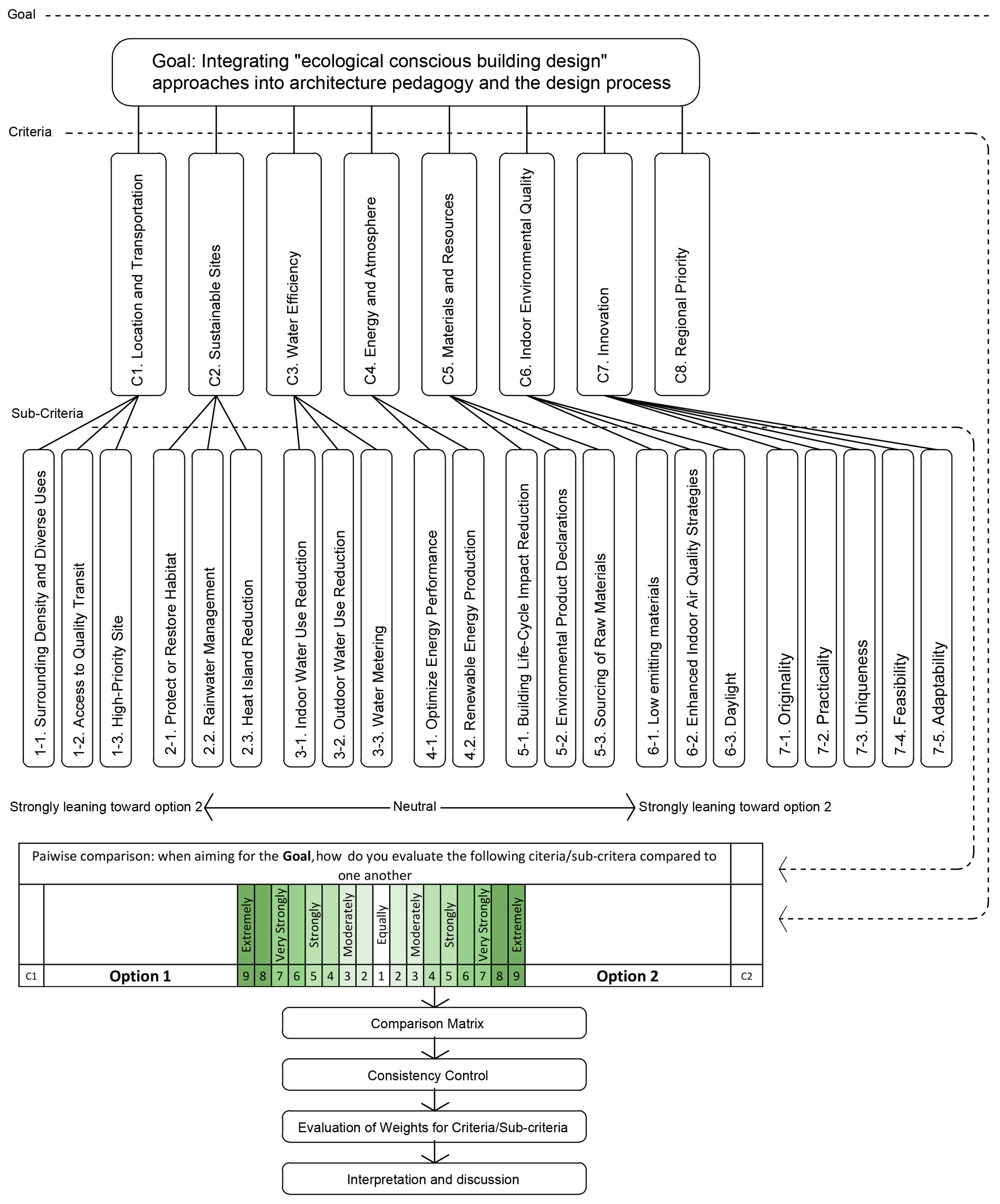
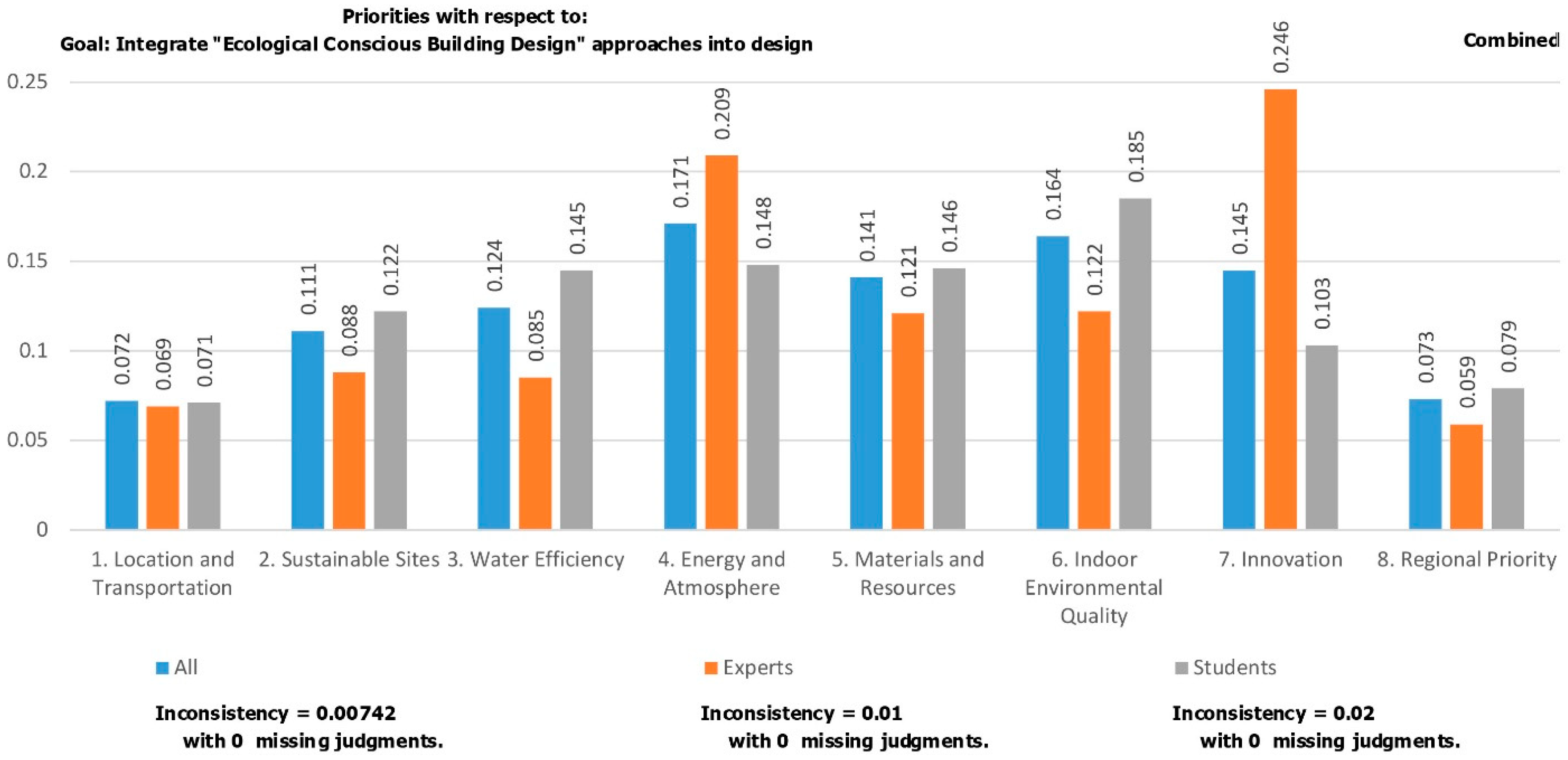
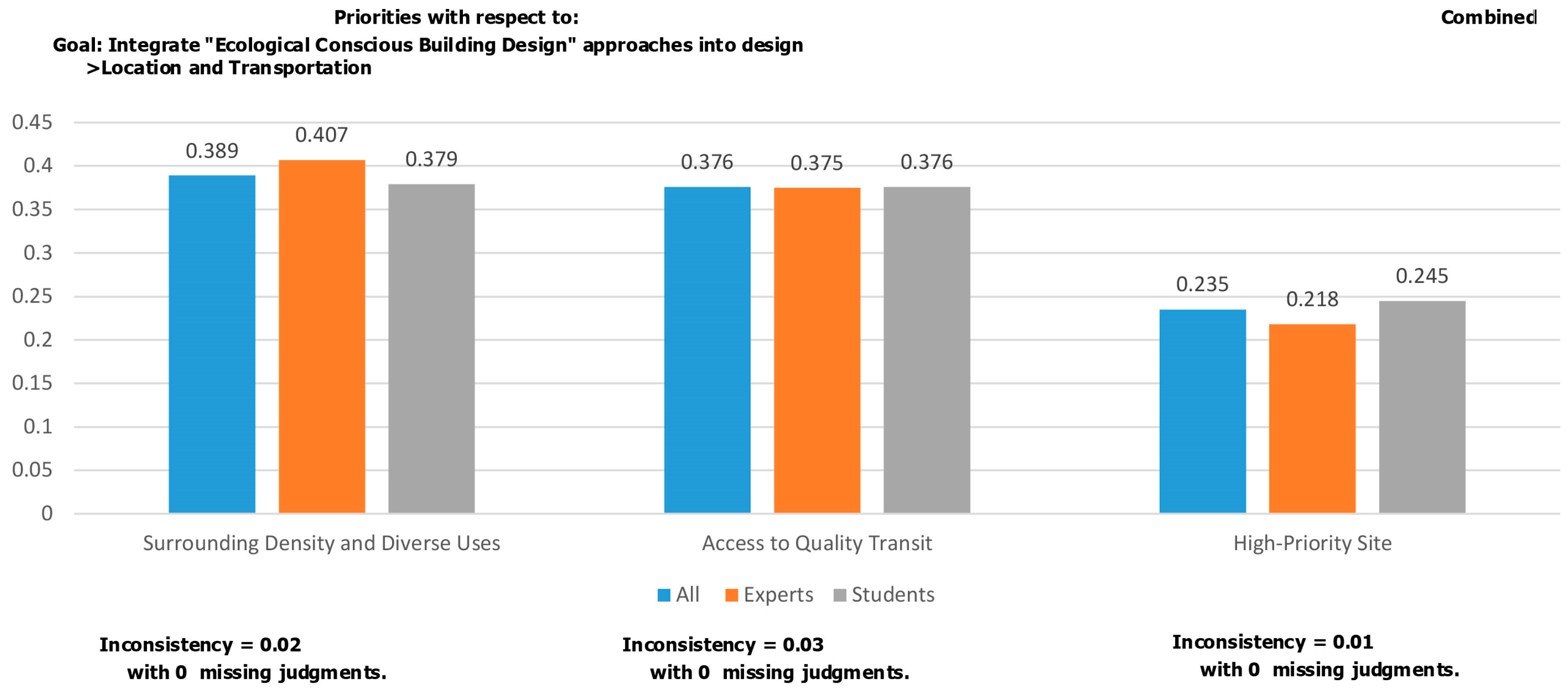
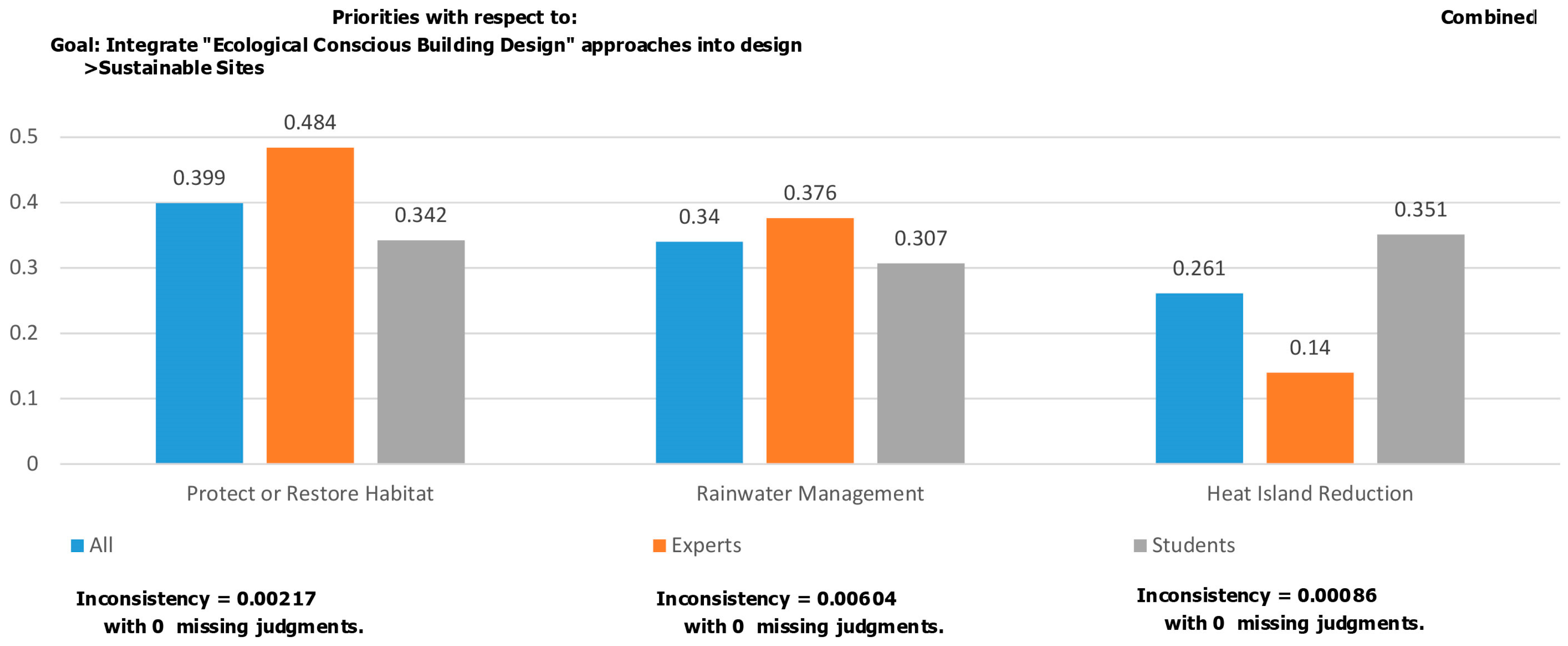
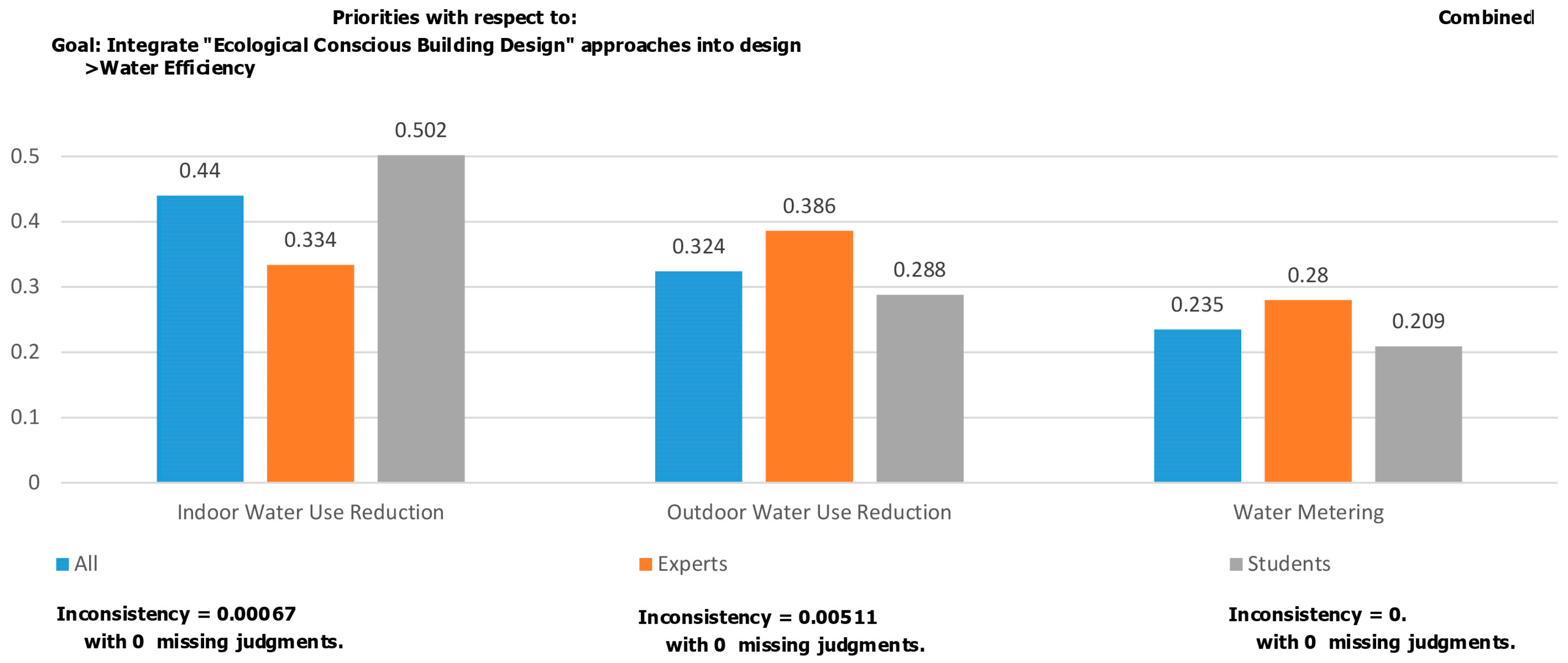
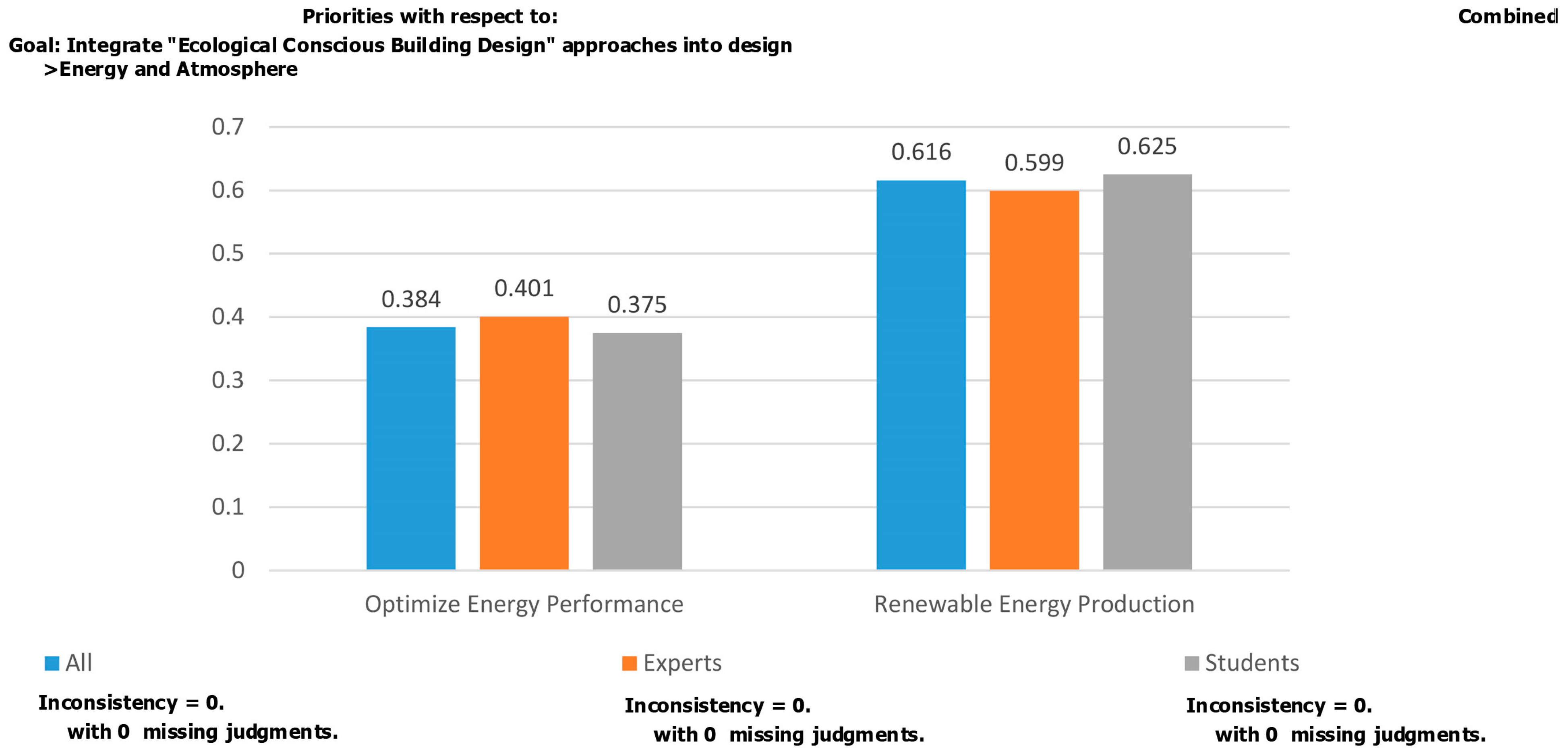


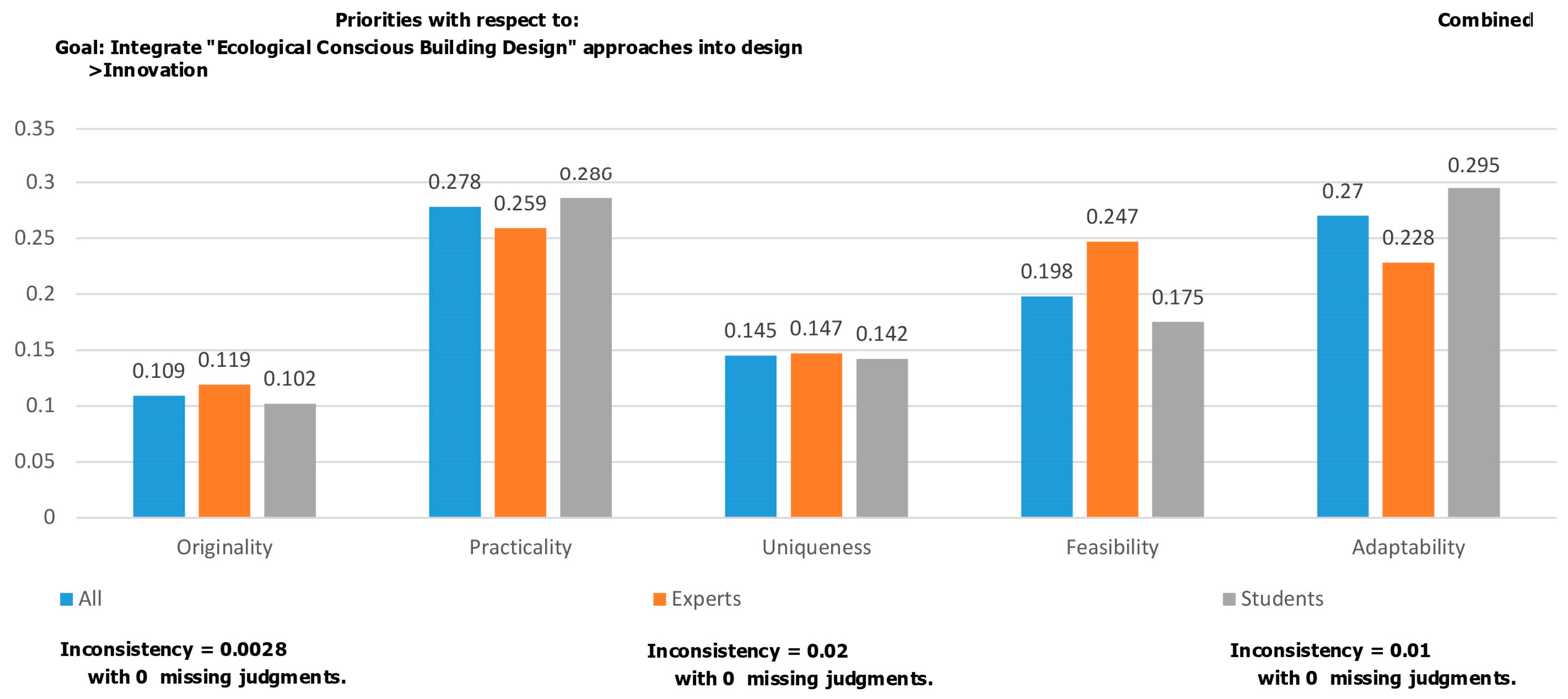
| Main LEED Criteria | Sub-Criteria | All | Experts | Students | All | Experts | Students |
|---|---|---|---|---|---|---|---|
| 1. Location and Transportation | Surrounding Density and Diverse Uses | 0.389 | 0.407 | 0.379 | 0.072 | 0.069 | 0.071 |
| Access to Quality Transit | 0.376 | 0.375 | 0.376 | ||||
| High-Priority Site | 0.235 | 0.218 | 0.245 | ||||
| 2. Sustainable Sites | Protect or Restore Habitat | 0.399 | 0.484 | 0.342 | 0.111 | 0.088 | 0.122 |
| Rainwater Management | 0.34 | 0.376 | 0.307 | ||||
| Heat Island Reduction | 0.261 | 0.14 | 0.351 | ||||
| 3. Water Efficiency | Indoor Water Use Reduction | 0.44 | 0.334 | 0.502 | 0.124 | 0.085 | 0.145 |
| Outdoor Water Use Reduction | 0.324 | 0.386 | 0.288 | ||||
| Water Metering | 0.235 | 0.28 | 0.209 | ||||
| 4. Energy and Atmosphere | Optimize Energy Performance | 0.384 | 0.401 | 0.375 | 0.171 | 0.209 | 0.148 |
| Renewable Energy Production | 0.616 | 0.599 | 0.625 | ||||
| 5. Materials and Resources | Building Life-Cycle Impact Reduction | 0.454 | 0.461 | 0.45 | 0.141 | 0.121 | 0.146 |
| Environmental Product Declarations | 0.276 | 0.277 | 0.275 | ||||
| Sourcing of Raw Materials | 0.27 | 0.262 | 0.275 | ||||
| 6. Indoor Environmental Quality | Low emitting materials | 0.216 | 0.224 | 0.21 | 0.164 | 0.122 | 0.185 |
| Enhanced Indoor Air Quality Strategies | 0.32 | 0.27 | 0.35 | ||||
| Daylight | 0.464 | 0.506 | 0.44 | ||||
| 7. Innovation | Originality | 0.109 | 0.119 | 0.102 | 0.145 | 0.246 | 0.103 |
| Practicality | 0.278 | 0.259 | 0.286 | ||||
| Uniqueness | 0.145 | 0.147 | 0.142 | ||||
| Feasibility | 0.198 | 0.247 | 0.175 | ||||
| Adaptability | 0.27 | 0.228 | 0.295 | ||||
| 8. Regional Priority | No Sub-criteria | 0.073 | 0.059 | 0.079 | 0.073 | 0.059 | 0.079 |
Disclaimer/Publisher’s Note: The statements, opinions and data contained in all publications are solely those of the individual author(s) and contributor(s) and not of MDPI and/or the editor(s). MDPI and/or the editor(s) disclaim responsibility for any injury to people or property resulting from any ideas, methods, instructions or products referred to in the content. |
© 2025 by the authors. Licensee MDPI, Basel, Switzerland. This article is an open access article distributed under the terms and conditions of the Creative Commons Attribution (CC BY) license (https://creativecommons.org/licenses/by/4.0/).
Share and Cite
Lotfabadi, P.; Iranmanesh, A. Evaluating the Incorporation of Ecological Conscious Building Design Methods in Architectural Education. Buildings 2025, 15, 1339. https://doi.org/10.3390/buildings15081339
Lotfabadi P, Iranmanesh A. Evaluating the Incorporation of Ecological Conscious Building Design Methods in Architectural Education. Buildings. 2025; 15(8):1339. https://doi.org/10.3390/buildings15081339
Chicago/Turabian StyleLotfabadi, Pooya, and Aminreza Iranmanesh. 2025. "Evaluating the Incorporation of Ecological Conscious Building Design Methods in Architectural Education" Buildings 15, no. 8: 1339. https://doi.org/10.3390/buildings15081339
APA StyleLotfabadi, P., & Iranmanesh, A. (2025). Evaluating the Incorporation of Ecological Conscious Building Design Methods in Architectural Education. Buildings, 15(8), 1339. https://doi.org/10.3390/buildings15081339







